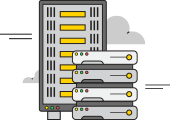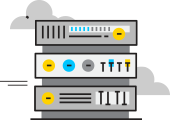Fiber to the Node (FTTN) is a revolutionary telecommunications technology that aims to bring high-speed internet access to homes and businesses by deploying fiber-optic cables to a central point in a neighborhood or locality, known as the node. From the node, the existing copper or coaxial cables are utilized to deliver internet services to individual premises. FTTN is a key part of the broader Fiber to the X (FTTx) family of solutions, which includes Fiber to the Home (FTTH) and Fiber to the Curb (FTTC).
The history of the origin of Fiber to the Node and the first mention of it
The concept of Fiber to the Node has its roots in the early 1990s when telecommunication companies sought cost-effective ways to upgrade their networks for broadband services. The idea was to leverage existing copper and coaxial cable infrastructure while integrating fiber optics for improved performance. The earliest mention of FTTN dates back to the late 1990s when various telecommunication providers began experimenting with the technology.
Detailed information about Fiber to the Node. Expanding the topic Fiber to the Node
FTTN revolutionized internet connectivity by addressing the limitations of traditional copper-based networks. It brought higher data rates, reduced signal degradation, and increased bandwidth capacity. The deployment of fiber optics up to the node allowed for significantly faster data transmission speeds compared to traditional DSL (Digital Subscriber Line) connections.
The internal structure of the Fiber to the Node. How the Fiber to the Node works
The internal structure of FTTN consists of two primary components: the Central Office (CO) and the node. The CO houses the main fiber-optic connection, which is connected to the internet backbone, ensuring a high-speed, stable connection. From the CO, fiber-optic cables run to the node located in a neighborhood or area, which acts as a distribution point. At the node, the fiber signal is converted into electrical signals to be transmitted over the existing copper or coaxial cables to individual premises.
Analysis of the key features of Fiber to the Node
FTTN offers several key features that make it a popular choice for internet service providers:
-
Cost-Effectiveness: FTTN allows providers to leverage existing infrastructure, reducing the overall deployment costs compared to full fiber solutions.
-
High-Speed Internet: While not as fast as FTTH, FTTN still provides significantly higher data rates and more bandwidth compared to traditional copper-based technologies.
-
Wider Coverage: FTTN enables providers to cover larger areas and serve more customers due to its ability to extend internet access over existing copper lines.
-
Scalability: The use of fiber optics to the node future-proofs the network, making it easier to upgrade to faster technologies in the future without replacing the entire infrastructure.
Types of Fiber to the Node
There are two main types of FTTN architectures:
-
Active FTTN: In this setup, the node includes active electronic equipment responsible for signal conversion and amplification. It offers more flexibility and can cover longer distances.
-
Passive FTTN: In this architecture, the node does not include active electronics. Instead, signal conversion and amplification are performed at the CO, with the node serving as a simple distribution point.
The choice between active and passive FTTN depends on factors such as the distance from the CO, the number of subscribers, and the service provider’s preferences.
FTTN is commonly used in various scenarios, including:
-
Residential Internet Access: FTTN brings high-speed internet to residential areas, enabling faster downloads, streaming, and online activities for households.
-
Business Connectivity: Businesses benefit from FTTN by gaining access to reliable and high-speed internet services, supporting their day-to-day operations and facilitating digital communication.
However, FTTN is not without challenges:
-
Distance Limitations: The distance between the node and the premises can affect the internet speed and performance. Users closer to the node generally experience faster speeds than those located farther away.
-
Copper Limitations: The use of existing copper lines may limit the maximum achievable data rates compared to full fiber connections.
To mitigate these challenges, service providers can invest in technologies like vectoring and bonding, which improve signal performance over copper lines. Additionally, regular infrastructure upgrades can help maintain a high level of service quality.
Main characteristics and other comparisons with similar terms
| Fiber Technology | Maximum Data Rate | Deployment Cost | Coverage Range |
|---|---|---|---|
| Fiber to the Node (FTTN) | Up to 100 Mbps | Moderate | Neighborhood/Small Area |
| Fiber to the Home (FTTH) | Gigabit+ | High | Individual Premises |
| Fiber to the Curb (FTTC) | Up to 1 Gbps | Moderate | Street Blocks/Medium Area |
FTTN, as shown in the table above, offers a balance between speed, cost, and coverage range, making it an attractive option for many service providers.
As technology continues to evolve, FTTN will likely see improvements in the following areas:
-
Higher Data Rates: Advancements in signal processing and copper line technologies may allow FTTN to achieve even higher data rates in the future.
-
Hybrid Solutions: FTTN may be combined with other technologies like 5G wireless networks to provide more robust and flexible internet services.
-
Growth of FTTH: While FTTN remains popular, the growing demand for ultra-high-speed internet may drive a shift towards FTTH solutions in the long term.
How proxy servers can be used or associated with Fiber to the Node
Proxy servers can enhance the FTTN experience by providing additional benefits:
-
Faster Access: Proxy servers cache frequently requested content, reducing the time it takes to retrieve data, especially for popular websites.
-
Anonymity: Users can access the internet through a proxy server, which masks their IP address, enhancing privacy and security.
-
Content Unblocking: Proxy servers can bypass regional restrictions, allowing users to access geo-restricted content and websites.
Related links
For more information about Fiber to the Node, you can explore the following resources:
- Telecommunications Industry Association (TIA)
- Fiber Broadband Association (FBA)
- Federal Communications Commission (FCC)
In conclusion, Fiber to the Node has played a crucial role in expanding high-speed internet access to various communities worldwide. Its cost-effective and scalable nature makes it an essential component of modern telecommunications infrastructure. As technology continues to progress, FTTN is expected to adapt and integrate with other emerging technologies, ensuring that it remains a relevant and efficient solution for internet connectivity.




